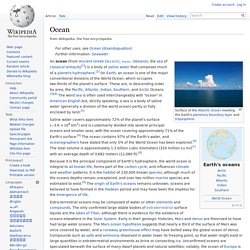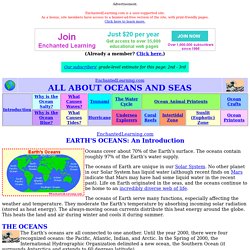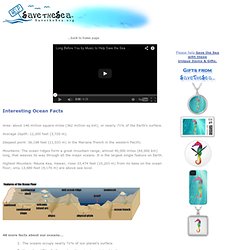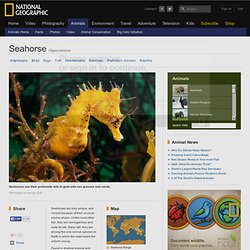

JPMorgan. Sea Anemones. As of July 1, 2013 ThinkQuest has been discontinued.

We would like to thank everyone for being a part of the ThinkQuest global community: Students - For your limitless creativity and innovation, which inspires us all. Teachers - For your passion in guiding students on their quest. Partners - For your unwavering support and evangelism. Sea Creatures. Sea Shepherd. National Oceanic and Atmospheric Administration.
Global carbon dioxide concentrations surpass 400 ppm Greenhouse gas rise is 'significant milestone'

Marine biology. Only 29 percent of the world surface is land.

The rest is ocean, home to the marine lifeforms. The oceans average nearly four kilometres in depth and are fringed with coastlines that run for 360,000 kilometres.[1][2] A large proportion of all life on Earth exists in the ocean. Exactly how large the proportion is unknown, since many ocean species are still to be discovered. The ocean is a complex three-dimensional world[3] covering about 71% of the Earth's surface. Ocean. An ocean (from Ancient Greek Ὠκεανός, transc.

Okeanós, the sea of classical antiquity[1]) is a body of saline water that composes much of a planet's hydrosphere.[2] On Earth, an ocean is one of the major conventional divisions of the World Ocean, which occupies two-thirds of the planet's surface. These are, in descending order by area, the Pacific, Atlantic, Indian, Southern, and Arctic Oceans.[3][4] The word sea is often used interchangeably with "ocean" in American English but, strictly speaking, a sea is a body of saline water (generally a division of the world ocean) partly or fully enclosed by land.[5] Earth's global ocean[edit] Global divisions[edit] Various ways to divide the World Ocean.
Marine Conservation Organizations. MarineBio is deeply committed to marine conservation and founded on the concept that, by sharing the wonders of the ocean and marine life, people will be inspired to protect it.

We hope you will consider becoming a MarineBio Conservation Society member to help us bring the ocean and the conservation message to as many people as possible. There are many other organizations working on marine conservation and other environmental issues such as biodiversity and global warming. We list them here both as a public service and to spread the word. Please Contact us if you have any comments, changes, or suggestions. » Invitation to fellow marine conservation groups For an objective annotated list of the organizations listed below and others, visit Mother Jones magazine's guide to environmental organizations. Oceanography Home. Overfishing - A global environmental problem, threat to our oceans and disaster. The Ocean. Earth's Oceans. Advertisement.

EnchantedLearning.com is a user-supported site. As a bonus, site members have access to a banner-ad-free version of the site, with print-friendly pages.Click here to learn more. (Already a member? Click here.) EnchantedLearning.comEARTH'S OCEANS: An Introduction Oceans cover about 70% of the Earth's surface. The oceans of Earth are unique in our Solar System. The oceans of Earth serve many functions, especially affecting the weather and temperature. The Earth's oceans are all connected to one another. There are also many seas (smaller branches of an ocean); seas are often partly enclosed by land. WEB LINKS ABOUT OCEAN LIFE, OCEANS AND WATER ON EARTHOcean Animal Printouts from Enchanted Learning. By Jeananda Col Enchanted Learning®Over 35,000 Web PagesSample Pages for Prospective Subscribers, or click below Click to read our Privacy Policy E-mail Copyright ©2000 EnchantedLearning.com ------ How to cite a web page.
Videos: The Death of the Oceans? Oceana North America. Ocean Facts. Interesting Ocean Facts Area: about 140 million square miles (362 million sq km), or nearly 71% of the Earth's surface.

Average Depth: 12,200 feet (3,720 m). Deepest point: 36,198 feet (11,033 m) in the Mariana Trench in the western Pacific. Sea Animals. Yahoo! Answers - Home. Welcome to Ocean Geographic Society. Oceans of the World - 5 Oceans, World Oceans. Reef Facts - Plants and Animals. Life in the Sea - Coral Reef and Sea Plants. STOP SHARK FINNING. Seahorses, Seahorse Pictures, Seahorse Facts. Seahorses are truly unique, and not just because of their unusual equine shape.

Unlike most other fish, they are monogamous and mate for life. Rarer still, they are among the only animal species on Earth in which the male bears the unborn young. Found in shallow tropical and temperate waters throughout the world, these upright-swimming relatives of the pipefish can range in size from 0.6 inches (1.5 centimeters) to 14 inches (35 centimeters) long. Male seahorses are equipped with a brood pouch on their ventral, or front-facing, side. When mating, the female deposits her eggs into his pouch, and the male fertilizes them internally. Because of their body shape, seahorses are rather inept swimmers and can easily die of exhaustion when caught in storm-roiled seas. They anchor themselves with their prehensile tails to sea grasses and corals, using their elongated snouts to suck in plankton and small crustaceans that drift by. Marine Life - Ocean Animals, Plants and Habitats. S National Ocean Service: Retired NOS Web Sites: Ocean Exploration Panel.
Sea Creatures. The Secret Life of Plankton. Numerous species of krill inhabit the world’s oceans.

(One world ocean particular species, Antarctic krill, has made headlines lately because of its alarming decline. What’s driving this decline? Why is Euphausia superbain (Euphausia superba?) Such an important species? Research the issue and identify what, if anything, can be done to curb the loss of Antarctic krill.